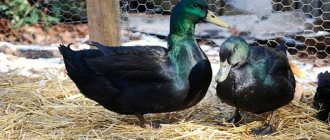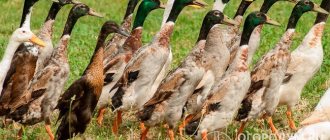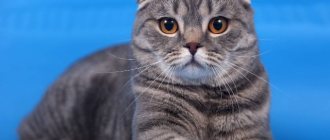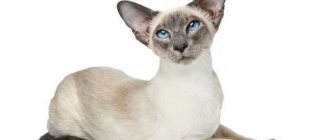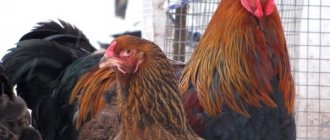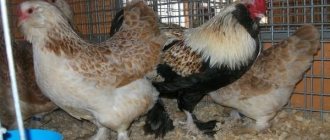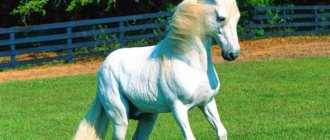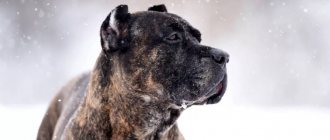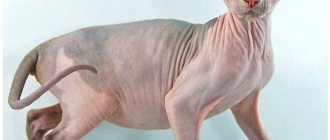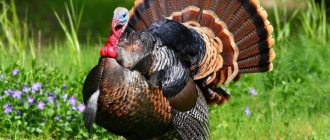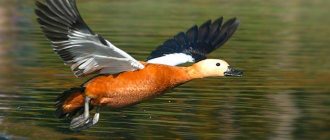Photo: zen.yandex.ru Ducks are bred on farms for meat, eggs and for beauty. And all because they are easy to maintain, unpretentious and cause almost no trouble. Did you know that there are actually dozens of species, and they are all very different? We have prepared a selection of the 25 most popular duck breeds - with photos and descriptions!
Ukrainian gray
Meat poultry, which is considered one of the best breeds of this type. The breed was bred by Ukrainian breeders.
Description. Birds have a wide muscular body, a powerful physique and fragile bones. The beak is dark, slightly concave. The animals have thick plumage, similar in color to that of their wild counterparts. Specimens with clay or white plumage are usually found.
Productivity. The little ducklings grow and develop well and gain weight quickly. Already at 2 months the weight of birds reaches 3.5-4 kg. Over the course of a year, one hen produces up to 120 large eggs weighing 85-90 g.
Content. Ducks of this breed are able to fully develop on grazing and independently obtained duckweed alone. The breed can be kept in unheated poultry houses. The main thing is to provide thick bedding and protect the house from drafts.
Advantages. Good productive performance, increased resistance to low temperatures and bird diseases. They also distinguish early maturity, intensive growth, and a high survival rate of chicks.
Flaws. The birds are unclean and also noisy.
Choosing ducklings
You need to buy chicks in early spring - at this time the best prices for birds are.
The meat will be ready by mid-April, when prices for duck are still very high, which significantly increases the profitability of duck farming. When choosing ducklings, you should pay attention to the following points:
- Place of purchase. It is better to use the services of an incubator, where there are documents for the birds and certificates for activities - the price is 5-10% higher, but there are at least some guarantees.
- Mobility and activity of the bird. Choose the noisiest and most active individuals that have shiny fluff (indicates good vitaminization of the body) and dry butts.
- A good appetite. If you take chicks, give them food, they should eat it with appetite. And this does not depend on whether they have eaten or not before. Literally 5 minutes after eating, the baby will peck food again if he is healthy.
The offspring must be transported in a homemade box - a cardboard box with holes on all sides for ventilation. Chicks are afraid of high temperatures and can suffocate if there is a lack of oxygen. If you drive for a long time, you can stop once for 1 hour and open the box so that the ducklings can breathe some air outside.
Russian Crested
The main feature is the crest on the head. Some people notice that the larger it is, the lower the productivity indicators.
Description. The Russian Crested Duck has a medium-length body and a strong build. Well developed muscles. The back is wide, slightly convex, the chest is rounded. There are no folds on the lush belly. There are specimens with a pure white color, and there are also multi-colored birds: they have thick feathers that fit tightly to the body. Ducks have long wings and an elongated, rounded head. Brown eyes and concave beak.
Productivity. The weight of ducks reaches a little more than 2 kg, drakes weigh about 3 kg. They have tender, juicy and tasty meat. Over the course of a year, one hen produces about 55 white or greenish eggs weighing up to 70-80 g.
Content. Ducks are unpretentious in their diet and are comfortable with water bodies. It is not recommended to overfeed them, as birds are prone to obesity. The room where birds are kept must be clean and dry, otherwise the animals may suffer from diseases.
Advantages. Birds are unpretentious in maintenance and nutrition. Characterized by high productivity and rapid growth.
Flaws. Low weight of Russian ducks.
Mandarin duck / Aix galericulata
The most beautiful duck in nature, according to the editors of most-beauty, is the mandarin duck. It belongs to the genus of wood ducks. They settled throughout the countries of East Asia, and in Russia these beauties can be found within Sakhalin, the Amur region and the Primorsky Territory.
They are small in size, weighing no more than 0.70 kg. Females and males differ in color. Males have a crest on their heads, and the color of their feathers is brighter than that of females. Males “put on” a particularly bright outfit during the mating season.
Mandarin ducks are excellent swimmers and excellent fliers. They dive very rarely, and sometimes they can be found on branches or coastal rocks. In Chinese mythology, mandarin ducks are considered a symbol of fidelity.
?
Bashkir
Breed of meat and egg orientation. Farmers of private farmsteads and industrial enterprises especially fell in love with these birds, due to the fact that they feed on almost any food and are able to independently satisfy their needs while walking in a meadow or on a pond.
Description. Ducks have protruding chests and a strong and muscular build. Large, widely spaced paws on short orange legs. The head is flattened on the upper side, located on a short, concave neck, curved outward. A concave orange beak with a wide growth that allows the birds to grab grass. The wings fit tightly to the body. The plumage is black-gray.
Productivity. Adult drakes weigh more than 4 kg, and ducks reach 3.7 kg. There is practically no fat in the carcass. The meat yield is at least 70%. One laying hen produces from 115 to 125 eggs weighing 70-80 g per year.
Content. The bird is unpretentious in care, so it will feel good in special cages and pens. In the room for ducks, it is imperative to maintain an average temperature in winter, and set the optimal temperature in summer - it should not be hot.
Advantages. High survival rate of ducklings - about 80%. Birds also have increased resistance to infectious diseases, grow and develop quickly.
Flaws. Birds need to constantly drink clean water and change bedding, otherwise the animals may be susceptible to disease.
Beijing
From the name it becomes clear that the origin of the breed is Chinese. The bird appeared in Europe in the 19th century and immediately became valuable to many private farm owners. The Peking breed is considered no less popular in Russia.
Description. Animals have special external characteristics. Pekingese have a strong build, broad chest and large back. The large head has a convex forehead and a bright orange beak. The head is located on a small, short neck. The wings have a large span and are well developed. The birds have thick white plumage. Occasionally there are specimens with cream feathers.
Productivity. An adult duck weighs about 3 kg, a drake reaches a weight of up to 4 kg, sometimes more. The young quickly gain weight and already at 2 months the drakes weigh 2.9 kg. During the year, laying hens lay more than 110 eggs weighing about 90 g.
Content. In winter, ducks need to be provided with a special room so that there are no drafts. It is equally important to maintain optimal temperature and lighting. When cold weather sets in, the temperature in the duck house should be at least +10 degrees, in summer - no more than +25 degrees.
Advantages. Early ripening, undemanding to feed, resistance to heat and cold. In addition, there is no need to keep the bird near a pond.
Flaws. Birds have poorly developed maternal instincts; ducks are overly sensitive to excess humidity.
Origin and domestication
According to the observations of scientists, all modern species of ducks descended from the once domesticated wild duck – the mallard. But as to when exactly this event occurred, opinions differ.
So, they call numbers from 1000 BC, when the domestication of wild ducks could begin in Asia, Europe, Africa and America. And at the same time, it is known that in the times of Ancient Rome, domestic ducks could fly, which is not typical for fully domesticated birds. In any case, ducks have been living in people's backyards for a very long time.
Musk (indot)
The Muscovy duck comes from South America, where the ancient Indians raised this bird for hundreds of years. In the countries of the former Soviet Union, the Indian duck appeared in the 80s of the last century. The breed allegedly received its name due to the specific aroma of the meat, but contemporaries do not feel anything like that.
Description. The bird's appearance is remarkable. There are bright growths on the top of the head, and it has a narrow beak that curls downward. On the top of the head there are elongated raised feathers; when the bird is frightened or surprised, they puff up even more. Muscovy ducks have blue, gray or brown eyes. The neck is strong and short. The chest is well developed. The back is long and wide. The body is placed almost horizontally. Short legs give it a stocky appearance. Birds come in brown, white, and blue colors. There are specimens with brown and white, black and white with a pattern.
Productivity. Adult males weigh 5-6 kg, ducks - 2-3 kg. At 2 months, the weight of the young reaches 3.8 kg for drakes and 2.2 for females. During the year, laying hens produce 90-100 eggs weighing up to 75 g. Egg products are valuable and healthy.
Content. Birds prefer dry and clean rooms. The poultry house should be spacious and light. Animals are picky about cleanliness for the reason that it affects the laying period. The room temperature is maintained at 18-20 degrees Celsius.
Advantages. Unpretentiousness in nutrition, developed maternal instinct, endurance, ability to live for a long time outside the reservoir.
Flaws. Long-term development and birds’ dislike of cramped conditions and “damp” conditions contribute to the development of diseases.
You can find out exactly what the Muscovy duck breed looks like and how to keep them in the video below:
Spotted Scoter / Melanitta perspicillata
Photo credit: / CC BY-SA
The wingspan of this bird from the duck family reaches 90 cm, and the length of an adult scoter grows up to 55 cm. Males have a black, white and red beak, because of which the whole species received an unusual name.
The color of the feathers is black, only males have two white spots on their heads. The female also has black feathers with a brownish tint. A quiet bird, only during the breeding season do males and females make unusual sounds. With an alarm cry, adults warn the chicks of danger.
They breed from Alaska to the Mackenzie River. In summer, they can be seen on the ocean coasts of the Atlantic and Pacific Oceans, as well as on the water surface of the Great Lakes.
By the way, on our website most-beauty.ru there is a fascinating article about the most beautiful lakes in the world.
6
Blagovarskaya
Most poultry farmers prefer to breed birds not only to produce eggs and meat products, but also to decorate their farmstead. Blagovarian ducks are just such birds, valued for their tasty meat and external characteristics.
Description. The birds are large in size and have a horizontal, elongated body. A large head is located on a flexible, elongated, short neck. The physique is strong - in appearance the bird resembles a broiler. The voluminous, elongated body with a rounded, developed chest especially distinguishes the bird. The beak is a deep orange hue. The legs are short, widely spaced, with orange or pink paws. The birds have snow-white plumage.
Productivity. The weight of adult drakes reaches 4.4-5 kg, ducks - up to 3 kg. During the year, the laying hen produces about 200-250 large eggs weighing 90-95 g. The shell is white. The fertilization rate of eggs reaches 98%.
Content. In winter, birds need a house to roost at night. The room is equipped with a heating and ventilation system, lighting, nests and feeders, drinking bowls, and windows.
Advantages. Rapid growth and weight gain. The birds have good meat performance and high productivity. The breed has increased resistance to various diseases.
Flaws. In order for birds to be healthy, grow quickly and gain weight, they need to be provided not only with good housing, but also with a balanced diet, which can be expensive.
Agidel
When working with these ducks, breeders tried to improve not only egg and meat productivity indicators, but also increase the animals' resistance to diseases and infections. They managed to achieve this.
Description. Ducks are characterized by a deep, protruding chest, a long and wide back, and a well-set and almost horizontal body. The animals have a long and large head with dark, high-set eyes and a wide beak of a white-pink hue. The neck is slightly thickened and relatively long. The body is firmly supported by short legs of a light orange hue. The plumage is white.
Productivity. The breed is valued for its high productive qualities. At the age of 2 months, birds weigh 3 kg. During this period, if the bird is not kept for breeding or keeping eggs, it is sent for slaughter. A duck produces up to 250 large eggs weighing up to 100 g in one season.
Content. Animals do not need permanent poultry houses because they can easily tolerate temperature changes. The only thing that is important to avoid is drafts. There must be a bowl of water in the room so that the birds can moisten their feathers.
Advantages. Agidel ducks quickly gain weight, produce a lot of eggs per year, and have increased resistance to diseases. The taste of meat is especially valued by farmers.
Flaws. Receiving a brood from an incubator due to poorly developed maternal instinct, fatty meat.
Hatching chicks
The laying location of birds depends on their breed. Birds can build a nest in thickets or in a hollow. The incubation process lasts from 3 to 4 weeks, starting from the moment the last egg is laid. For the first 2 weeks, the female does not leave the nest at all. After this, it is insulated with down and goes for food.
There are from 6 to 18 chicks in one nest. The duck chick emerges from the egg within 10-14 hours, after which it quickly dries out. Plumage and the process of learning to fly occurs at the age of 5-7 weeks. When the female teaches her offspring to fly, she begins to molt.
Blue favorite
A breed bred not so long ago - about 20 years ago. Peking duck was used for crossbreeding. At a factory in Bashkiria, breeders selected and crossed ducks for a long time in order to obtain the final positive result. The second name of the bird is Pharaoh.
Description. Blue ducks are considered large birds. At 6 months, the bird is in no way inferior in size to geese of the same age. The Pharaoh has a dense, heavy build, a protruding chest and a long, low-slung body. The neck is strong and of medium length. A wide, large gray beak and large dark eyes. The body is supported by strong, short legs of yellow or gray color. The wings are small and fit tightly to the body. There are specimens with blue, red, gray, white, black and combined plumage.
Productivity. With a balanced diet, birds weigh about 3 kg already at two months of age. The average weight of drakes is up to 5 kg, sometimes 7-8 kg. Females weigh less - about 4 kg. Over the course of a year, one hen produces from 100 to 150 large eggs weighing 80-85 g.
Content. The Blue Favorite is a low-maintenance breed. It is not necessary to equip a special duck pen; a regular pen will be enough for the bird. The animal adapts well to climatic conditions.
Advantages. The Pharaoh has many advantages that make the breed popular for breeding:
- birds have a beautiful appearance;
- animals quickly gain weight;
- Birds produce tasty lean meat.
Flaws. Birds have poorly developed maternal instinct. For this reason, ducklings are hatched only using an incubator or hens of other breeds.
Mulards
Breeders created a hybrid in order to improve the qualities of the parent breeds to obtain a new, improved specimen. For crossing, indo-duck and domestic duck of the Peking white, Rouen, etc. breeds are used.
Description. The birds have a special appearance, making them difficult to confuse with other ducks. The sizes are large, the body is dense and elongated. On a strong, long neck there is an oval, small head. The body is supported on strong legs with short yellow-orange legs. The eyes are dark, the beak is flat, light yellow, and slightly elongated. The feathers fit tightly to the body. The feather color is predominantly white. The birds are calm, not noisy and clean.
Productivity. The hybrid has high productive qualities. In the first 2-3 months, ducks weigh 3.5-4 kg; at four months of age, body weight reaches about 6 kg. Duck meat is lean, especially valued in cooking and considered a delicacy.
Content. It is permissible to keep ducks in an insulated shed where they will spend the night. Birds also need to be given free space to walk. The temperature in the poultry house should be no lower than +16 and no higher than +25 degrees.
Advantages. Calm disposition, precociousness, cleanliness, high meat performance, ease of care.
Flaws. Mulards are not found in the wild and are not able to reproduce on their own. Birds are raised exclusively at home.
A breeder of Mulardy ducks shares his experience of breeding them in the following video:
Poultry house for large ducklings
According to recommendations for breeding ducks at home for beginners, the area of the poultry house and aviary for walking should be increased as the ducklings grow. Month-old ducklings will need 1 sq. m. for 8 individuals. The stocking density for adult two-month-old birds cannot be higher than 3.5 birds per meter.
The duck territory should be equipped with the following equipment:
- feeders - it is best to make wooden ones;
- drinking bowls - calculation of 0.6 liters of liquid per duck, the sides of the drinking bowls are 20 cm high;
- nests for eggs (1 nest for 3 ducks);
- artificial lighting devices;
- ventilation system and heating system.
To work with birds after slaughter, freezers and plucking machines are useful.
The walking area is fenced with a metal mesh. Place the “pasture” on a high area so that rains do not flood the site.
Cherry Valley
The breed comes from England. The desire of British breeders was to develop a breed that would have maximum meat productivity without loss of egg production. Peking ducks were involved in the breeding. Selection was carried out simultaneously on the paternal and maternal lines, which in both cases gave good results.
Description. Externally, the birds are similar to their ancestors. At birth, the chicks receive yellow plumage, which lightens over time, becoming snow-white. The body is directed vertically, elongated. Birds have a wide chest, pronounced muscles, and feathers that fit tightly to the body. The body stands on low, strong legs of a red-orange hue. A small head with a convex forehead is located on a thick neck. The beak is curved, yellow-orange. Eyes blue or dark blue.
Productivity. The weight of the duck reaches from 3.4 to 3.7 kg. The drake weighs about 3.5 to 4 kg. Over the course of a year, a laying hen produces 120-150 large eggs weighing 70-90 g. The hatchability of young animals is about 95%.
Content. There are practically no difficulties with maintaining the breed. In order for animals to feel comfortable, they need to equip a warm room, install feeders and drinking bowls.
Advantages. The advantages of the breed include fast growth, attractive appearance, high productivity, and unpretentiousness in food.
Flaws. Birds of the Cherry Valley breed have almost no disadvantages. The only difficulty a breeder may encounter is the need for access to water and walking.
American Duck / Oxyura jamaicensis
Photo credit: / CC BY-SA
The photo shows another representative of the warbler family, living in vast areas of North America. Scientists distinguish three species, one of which has acclimatized to live in the British Isles.
Nest in natural places near fresh water bodies. They need a large area of open water in which to land and take off. They feed on crustaceans, as well as seeds of coastal plants.
They make practically no sounds, only males make drumming sounds during the mating season. They rarely fly, preferring to spend time on the water. The population is not threatened by anything other than oil spills in the Gulf of Mexico.
7
Indian runner
Previously, this breed was called the penguin. This name comes from the unusual shape of this duck species. Even at the beginning of the 20th century in Europe, the breed was considered rare, the birds exotic - ducks were exhibited in zoos.
Description. Externally, the Indian Runner differs from other duck breeds: it has a unique body shape, resembling an elongated bottle. The feathered animal has a slender and tall body with a vertical orientation and a rounded chest. The feathers are smooth, lying close to the body. The color of the plumage varies.
Productivity. The weight of adult runners can reach one and a half to two kilos. Females are smaller than drakes. Already in the first month of good fattening, ducklings catch up with adult birds in weight and size. Egg indicators are much better - a laying hen produces 200-250 large eggs per year, sometimes the number reaches 300-350 pieces.
Content. If ducks have the opportunity to graze on pasture near a pond, maintenance costs will be minimal. Indian runners can find their own food all day long.
Advantages. Animals run fast and are active. They have increased resistance to diseases. They grow quickly. They are not afraid of snow and frost.
Flaws. Ducks are shy and can panic at the slightest noise. It is not advisable to raise birds for meat.
Spectacled Eider / Somateria fischeri
The unusual bird got its name because of the characteristic color of its head. The spectacled eider has swollen round spots around its eyes that resemble glasses.
This is a fairly large duck, reaching a weight of 1.4–1.7 kg. An amazing sea duck has inhabited the rocky shores of Alaska and North-Eastern Siberia. It makes nests in a small coastal zone of the tundra near swamps, flowing streams and rivers. Like most relatives of this species, it feeds on sea mollusks.
The population is declining sharply due to the development of the oil industry within the Arctic Ocean.
8
Star 53
Star-53 is a cross from the Peking duck. The cross was created by a French breeder at the Grimaud freres selection company.
Description. Externally, the bird is similar to its ancestor. She has snow-white plumage. Large dimensions. Bright yellow beak and feet. Massive back, elongated body, powerful and wide chest, protruding forward. The round head rests on a thick, muscular neck. The tail is strong, the wings are long.
Productivity. By the age of two months, the bird weighs about 4 kg. The percentage of meat in the carcass is more than 60%. Over the course of a year, a laying hen produces up to 300 large eggs weighing about 90 g or more.
Content. Birds should not be kept in close quarters. If the birds do not have space, they will behave restlessly, fussily and noisily. In the poultry house, it is important to adhere to the optimal temperature regime - it should not be hot and not cold.
Advantages. Already at 2 months they receive large meat carcasses with minimal fat content. Birds are also valued not only for their appearance, but also for their high egg production and ease of care and maintenance.
Flaws. It is impossible to keep them indoors all the time; it is problematic to purchase really high-quality young animals, the high cost of hatching eggs, and the high cost of feed.
Shoveler - photo
Already from the name it is clear that ducks of this species have a spade-shaped, widened beak. Among all the ducks, the Shoveler Drake is the most beautiful . It is different:
- red belly and sides;
- white breasts;
- dark green neck and head;
- bright yellow eyes;
- bright orange paws.
The “mirror” of the male’s wings is bright green, the front wings are blue.
The brown-red female has brown eyes. She makes rhythmic sounds similar to “pi-it, pi-it.” The drake quietly and nasally utters “sok-sun, sok-sun.” The Shoveler is one of the most wary duck species.
Moscow Whites
The Moscow white duck was obtained by crossing a Peking duck and a Cambell drake. The breeding was carried out by Russian breeders, who managed to obtain birds with high productivity indicators.
Description. The birds have a rather large, slightly oblong head and a massive, strong body. Wide chest and back. The body is placed horizontally relative to the ground. The beak is pink or red. The short legs and paws are orange.
Productivity. The average weight of adult individuals reaches 3.8-4 kg. During the year, one female brings about 150 large eggs weighing 85-90 g. But more often the breed is bred for meat.
Content. An important characteristic of the breed is its ability to quickly adapt to different weather conditions. The birds are unpretentious in keeping and have strong immunity. In winter, it is permissible to keep them in an unheated but insulated poultry house.
Advantages. Fast growth, tasty and soft meat.
Flaws. Requires good nutrition, but this allows the bird to gain weight faster.
Rouen ducks
Previously, ducks of this breed were wild birds. Farmers value it for the good taste of meat and its minimal fat content.
Description. Ducks have a heavy build with a horizontal stance, a deep chest, an oval back and a tail with curls. The body is supported by short limbs. The beak is large with a greenish tint. The head is small, located on the neck with a strong bend.
Productivity. On average, an adult duck weighs 3.8 kg, and a drake weighs about 4 kg. One female produces only 90 eggs per year.
Content. Caring for birds is simple and practically no different from keeping other birds. Ducks need to be provided with artificial reservoirs in the absence of natural ones. To do this, use large containers or troughs.
Advantages. The breed is often bred to decorate a farmstead or take part in exhibitions. But those who raise poultry for meat can safely say that the product is juicy, aromatic and very tasty.
Flaws. Tendency to obesity and poorly developed maternal instinct.
Nutrition and feed
The ducks' diet consists of grain and green feed.
Grain feed must be moistened - soaked in water for 10-12 hours. They use alfalfa flour, peas, and vetch flour for this. Granular feed is best suited for ducks.
Ducks readily eat young greens, clover, alfalfa, nettles, cabbage leaves, weeds, as well as steamed and raw potatoes, carrots, beets, and silage. Green feed for ducks is finely ground.
A real delicacy for domestic ducks is pond plants, for example, duckweed, which is excellent for feeding ducklings.
Adult ducks are fed three times a day. In the morning and at lunchtime, the birds are given wet mash, and for dinner - grain feed.
It is important for birds to have a constant supply of clean drinking water in a volume of at least 1.5 liters per day per individual.
Swedish blue
A meat breed bred in Sweden. Today Swedish blue ducks are popular in Germany and Russia.
Description. Birds have a large, dense build. They have a non-convex chest, a wide and straight back, a short and straight tail. The head of the birds is oval in shape, the beak is flattened. The main definition of the breed is the blue tint of the plumage.
Productivity. Adults reach an average weight of 3-3.6 kg, drakes - about 4 kg. Over the course of a year, a laying hen produces 100 to 150 small, oval eggs with a blue or greenish shell.
Content. Birds are not picky about their maintenance. During the warm season, a fenced area is set up for them, the area of which should be spacious. This place is often equipped with artificial pools and planted with various vegetation.
Advantages. Unpretentiousness in care and nutrition, resistance to diseases.
Flaws. Slow weight gain. In order to send a bird for slaughter, you have to wait a long time.
Gastronomic value
Ducks are not as popular in cooking as chicken or, for example, turkey, due to the rather specific taste of their meat, and until recently this bird was considered more wild than domestic.
It could only be found in the form of gourmet dishes on the menus of expensive restaurants, and, yes, baked, on Christmas tables.
But if you still find a way to cook duck correctly, you will be surprised to find out that there are many different recipes and methods, and with proper adherence to the technology, its meat can be subjected to any heat treatment.
Black white breasted
The breed was created by breeders from the Institute of Poultry Science of the Ukrainian Academy of Agrarian Sciences. Khaki Campbell, Peking, and Ukrainian White-breasted ducks were used for breeding.
Description. Birds are characterized by a massive body, a long, broad back, and a large and concave chest. On the long neck is a small head with a short, blunt beak and large black eyes. The legs are short, the tail is small, and the feathers fit tightly to the body. The birds have black plumage and white down on the chest.
Productivity. The average weight of ducks reaches up to 3.5 kg, drakes - up to 4 kg. During the season, a laying hen produces 110-130 white eggs weighing 85-100 g.
Content. Black white-breasted ducks are waterfowl and therefore require ponds or small containers of water. When keeping a large number of birds, it is recommended to arrange a brooderhouse, where separate sections are provided for the free movement of birds.
Advantages. Well-developed maternal instinct, rapid growth and weight gain, unpretentious maintenance, calm disposition.
Flaws. Under inappropriate conditions and poor nutrition, there is a risk of decreased egg and meat productivity.
general characteristics
Ducks belong to a large, widespread family of waterfowl that includes about 150 species . They all have a streamlined, wide body, flipper-like membranes on their paws and a flattened beak. The plumage of ducks is completely waterproof, which is facilitated by fatty lubricant secreted by the coccygeal gland.
However, the bird needs to wash its feathers thoroughly on a regular basis. To do this, they run through the water, loudly flopping their wings. Ducks that have not bathed for several days may drown the first time they hit the water or will have difficulty swimming, being partially submerged in the pond. Dirty feathers also interfere with flight. Birds that have bathed come ashore and shake themselves off well, which helps restore the structure of their feathers, which have been damaged by water. After this, they use their beak to catch fat from the coccygeal gland and apply it to the feathers.
Nutritional Features
Most species of ducks feed on plant food , and in some cases, animal food:
- The diet of wood ducks includes grass and roots dug from the ground.
- Steamboat ducks and marine duck species dive well and find food at the bottom of reservoirs. They feed on crustaceans and mollusks.
- Diving ducks dive into the water until only their tail remains on the surface. Their diet includes zooplankton, algae, worms, mollusks, and insects.
- Mergansers behave more efficiently under water, so they easily catch sea fish for themselves.
Most ducks feed on the surface of the water, capturing water in their beaks, where it is filtered, leaving various algae, plant particles, small invertebrates and plankton behind.
Khaki Campbell
A British breed of duck, bred in the late 19th century by poultry farmer Adele-Campbell. It received its name not only from the name of the breeder, but also due to its unique coloring.
Description. Ducks are small, which is why they have relatively small body parts. An oblong sheepskin coat with a deep chest and strong, short legs. On a thin brown neck is a small head with dark, shiny eyes. The wings are not fully developed.
Productivity. The weight of an adult drake reaches up to 3 kg, ducks - 2.2-2.5 kg. Starts to gain most of the weight by 3-4 months. Laying hens produce up to 350 eggs weighing 80 g per year.
Content. To keep birds comfortably, the farmer needs to take care of good pastures and ponds. A water diet can easily replace most of all feed.
Advantages. High egg production rates, delicate taste of meat, active birds and calm character.
Flaws. If the conditions of keeping the birds are not observed, they not only gain weight poorly, but also behave restlessly.
Reproduction
Not all breeds of ducks make good brood hens. So, Pekin ducks are not suitable for these purposes, but musk ducks are distinguished by a developed instinct for incubating eggs. Therefore, before the duck begins to hatch, it is checked on “deceptive” eggs.
Each duck should have a separate, closed and spacious nest with soft material as bedding.
One hen usually hatches up to 20 eggs, leaving the nest only for bathing and feeding. Pekin ducklings hatch on the 28th day, musk ducklings on the 35th.
Duck eggs can be incubated at 38°C and good ventilation. On the 20th day, the temperature is reduced to 30 °C.
Pace
Breeders who have been working with the X-11 duck breed for a long time were able to achieve good results and develop a new species. Tempo, compared to other breeds, is characterized by good productive characteristics and early maturity.
Description. The birds have a large, oval body with a small tail and yellow, large paws. The bird has a small head with a large, yellow beak and two black eyes. The head is supported on a pronounced, long neck with a slight bend. Wings with dense snow-white plumage.
Productivity. Birds at two months of age already weigh about 3 kg. Typically drakes are larger than ducks. Laying hens produce 150-160 large eggs per year.
Content. The bird can do without a pond, but water containers are installed in the walking area. It is also necessary to equip the place with a canopy to protect the birds from rain or sun.
Advantages. Birds are easy to care for and can get used to low temperatures.
Flaws. Good weight gain requires proper nutrition, which can be expensive.
Habitats
Ducks live everywhere except the North and South Pole. The ideal habitat for a duck is an area with a body of water: a lake, river, bay, stream, or wetland. The habitat must be rich in vegetation. Eiders prefer sea coasts and often settle on rocks. Mandarin ducks prefer dense forests and create nests in tree hollows. Mallards live near bodies of water and make their nests in thickets.
Species that live in places where water bodies are covered with ice in winter migrate, and return in the spring. In many cases, mallards move into territory that is closer to people in the winter. They quickly get used to people and are not afraid. Therefore, a person can feed birds with special food during the cold months. Flights are made only when the duckling is strong and ready to travel. The migratory area of birds is usually rich in food. Chicks begin to fly at 5 months.
Medeo
The birds were bred in Kazakhstan. After several cycles of crossing the X-11 cross with the Peking duck, it was possible to obtain this breed with improved egg production and early maturity.
Description. Externally, the bird is especially similar to Cherry Valley ducks, and the color has passed from the Peking duck: white plumage, yellow-orange beak, large reddish-orange paws.
Productivity. Already at two months, the female weighs 2.5-2.9 kg, the drake - 3.3 kg. In adulthood, the weight of a duck can be up to 4 kg, a male – up to 5 kg. During the year, the female produces up to 140 large nutritious eggs.
Content. The birds are easy to care for and can thrive in a small area or in cages. It is advisable to provide the birds with a free run, but this is not a prerequisite.
Advantages. Minimum feed consumption, birds' adaptability to life in any conditions, high productive performance.
Flaws. No negative aspects were noticed.
Duck life
All these physical features, including the ability to swim, achieved thanks to powerful webbed feet, make the duck capable of living in any geographical and climatic conditions. You won't find it except in Antarctica. The conditions are too harsh.
In general, this bird is located where there is a body of water. Therefore, duck hunting enthusiasts know that a body of water surrounded by dense coastal vegetation is a sure sign that game is present here. After all, water bodies are their main source of food.They feed on small fish, tadpoles, and adult frogs. And they use bushes, or, more often, reeds, as a means of shelter.
With the onset of spring comes the breeding season. The duck begins to lay eggs. One per day, until their total number reaches 12-13 pieces, after which the duck begins to hatch them for a month.
Often a duck's laid egg can be found in someone else's clutch. This bird tends to throw them into other people's nests.
Cayuga
Unusual black birds were discovered in 1809 near Cayuga Pond in New York. Residents began to domesticate wild birds that flew in for the winter, crossing them with local breeds. The result of selection was the formation of the Cayuga breed.
Description. A characteristic feature of the birds is their beautiful, dark plumage, shimmering in various shades of blue and green, with a metallic sheen. The oblong body of birds is massive and strong, with thick plumage and wings that fit tightly to the body. The animals have a wide chest, a small, erect tail and short, strong legs. A small round head with a wide, black beak and dark brown eyes.
Productivity. Females weigh about 3-3.2 kg, drakes - 3.5-4 kg. During the year, ducks produce up to 150 eggs weighing 75-100 g.
Content. Birds are unpretentious and undemanding when it comes to food. It is recommended to keep them if they have free range.
Advantages. They provide tasty meat and egg products with minimal care and economical feeding.
Flaws. If birds are poorly maintained and fed with low-quality food, they can often get sick.
Today, numerous breeds of ducks are bred on private farmsteads and large farms, giving preference to those varieties that have good productive performance. After all, it is these characteristics that make it possible to obtain a high-quality product and profit from the sale of meat carcasses or eggs.
0
0
Copy link
